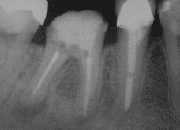| Apicoectomy | |
|---|---|
 X-ray of a tooth after root end surgery | |
| ICD-9-CM | 23.7 |
| MeSH | D001047 |
A root end surgery, also known as apicoectomy (apico- + -ectomy), apicectomy (apic- + -ectomy), retrograde root canal treatment (c.f. orthograde root canal treatment) or root-end filling, is an endodontic surgical procedure whereby a tooth's root tip is removed and a root end cavity is prepared and filled with a biocompatible material. It is an example of a periradicular surgery.
An apicoectomy is necessary when conventional root canal therapy has failed and a re-treatment was already unsuccessful or is not advised.[1] Removal of the root tip is indicated to remove the entire apical delta ensuring no uncleaned missed anatomy. The only alternative may be extraction followed by prosthetic replacement with a denture, dental bridge or dental implant.
State-of-the-art procedures make use of microsurgical endodontic techniques, such as a dental operating microscope, micro instruments, ultrasonic preparation tips and calcium-silicate based filling materials.
In an apicoectomy, only the tip of the root is removed. This is in contrast to root resection, where an entire root is removed, and hemisection, where a root together with its overlying portion of the crown are separated the rest of the tooth and optionally removed.[2]
- ^ "Endodontic Microsurgery". Compendium of Continuing Education in Dentistry. June 2007. ISSN 1548-8578.
- ^ "Endodontists' Guide to CDT 2017" (PDF). American Association of Endodontists. 2017. pp. 13–14. Retrieved 2020-03-14.